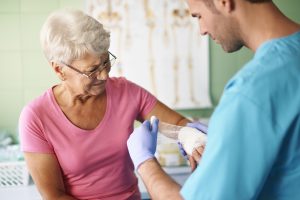October 2 Is World MRSA Day: What Is MRSA?
October 1, 2018
There are bacteria all around us and it’s probably a safe bet that we don’t know the names of most of them. On one hand, bacteria aren’t all bad and we need them. These microscopic single-cell microorganisms can help us digest food, for example. On the other hand, some bacteria can make us seriously ill, causing bacterial infections that can lead to sepsis. One such bacteria is methicillin-resistant Staphylococcus aureus or MRSA, pronounced “mersa.” October 2 in World MRSA Day, a day dedicated to raising awareness of this bacteria and how to prevent its spread.
MRSA is a type of staph infection. According to the Centers for Disease Control and Prevention (CDC), one in three people carry some type of staph bacteria and two in 100 people carry MRSA. What makes MRSA so serious is it is resistant to many of the antibiotics we use today, making it difficult to treat. For most people, this is generally not a problem. But if you have a break in the skin – a cut, burn, or scrape perhaps – MRSA can enter your body and start to cause damage. MRSA is also a risk for people who have a compromised or impaired immune system, as they aren’t able to fight infections as effectively as they should.
Healthcare-acquired infections
MRSA has caused serious problems in the healthcare setting as a healthcare acquired infection (HAI). Patients in hospitals and other healthcare facilities are already compromised, making them more vulnerable to contracting MRSA bacteria from other patients, visitors, or staff members. One in 20 patients gets an infection while receiving hospital care. MRSA infections can present in any number of ways, such surgical wound infections or pneumonia, or even blood stream infections, which can occur from invasive devices. That being said, statistics do show that healthcare facilities are improving in reducing the spread of MRSA and life-threatening MRSA HAIs are declining. However, the number of MRSA infections occurring in the community is now rising.
MRSA lives for days, weeks on solid surfaces
To contract MRSA bacteria, you must come in direct contact with it. The bacteria can be found on skin, or in the nose, urine, stools, or wounds. Anyone who carries the bacteria can unknowingly transfer it on any surface, such as a counter, door knob, or handle on the bus or subway. Because MRSA can live a long time on such surfaces, many people may touch the contaminated surface and transfer the bacteria to themselves.
Close contact, such as shared living quarters, playgrounds, gyms, and communal showers, increases the risk of exposure to MRSA, particularly if you share personal items, such as towels or razors. The spread of MRSA can be minimized by thorough and proper handwashing, either with soap and water, or with a waterless cleanser, and by not sharing personal items. Any break in the skin should be cleaned thoroughly and kept covered until healed.
Signs and symptoms of MRSA infection
Skin infections caused by MRSA are not always an obviously infected wound. You may at first think you’ve been bitten by a spider because the infection often first appears like a single raised lump or large pimple. Other signs include:
- Redness around the wound
- Swelling around the wound
- Increasing pain instead of decreasing
- Draining pus or fluid
- The area around the wound is warm to touch
You may also have a fever.
If you have any of these signs, see your doctor or nurse practitioner as soon as possible for treatment, as any infection can potentially become worse and trigger sepsis.
Other MRSA infections, such as pneumonia or a urinary tract infection, have symptoms related to the affected body part.
MRSA can be treated
If you have as skin wound that has a lot of pus or drainage, your doctor may need to drain it by using a small needle to withdraw the fluid or by making a tiny cut in the skin. Don’t try to do this at home as you could spread the infection, making things worse.
Certain types of antibiotics may still be effective in treating MRSA infection. You may be given an ointment if you have a skin infection, in addition to oral (pill) antibiotics. It is essential that you complete the prescription, even if you feel better. The infection may still be present even if you no longer feel the effects. If you are in the hospital, you may be put on intravenous (IV) antibiotics to treat the infection.
Infection with the MRSA bacteria is serious, but with good hygiene practices and vigilance, infection can be prevented or treated. This in turn reduces the risk of sepsis.






























